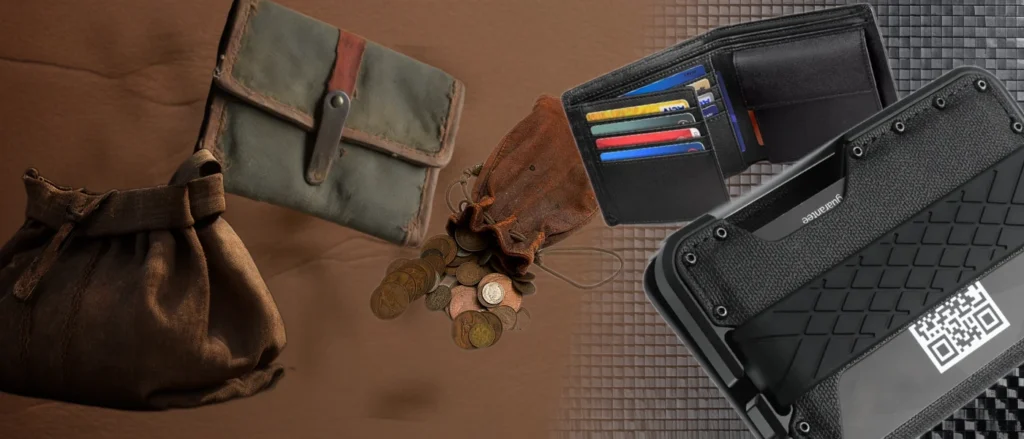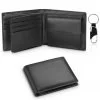There isn’t a specific record of the first finding of a wallet in history or archaeology, as wallets, in the modern sense, have evolved over time. The concept of carrying personal items and valuables dates back thousands of years, but the form and function have changed.
Ancient Wallets: From Pouches to Satchels
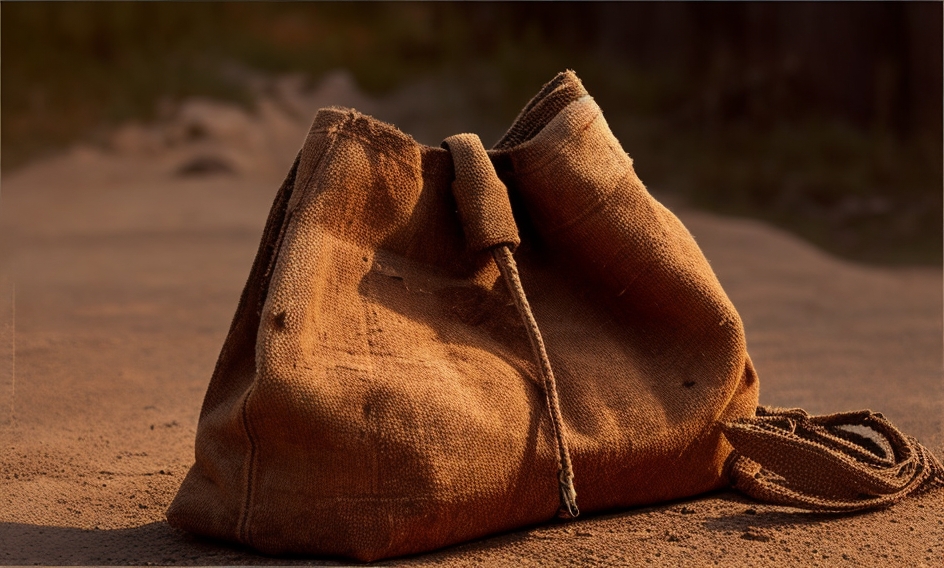
Interestingly, early versions of what we now consider the wallet were found on the “Ice Man,” a prehistoric man discovered in Italy. This coin pouch-like item offers a fascinating insight into the evolution of personal accessories. These remains, dating back to 3300 BC, offer a snapshot in time when people first sought an organized method to carry their personal items.
In ancient civilizations, such as Mesopotamia, Egypt, and Rome, individuals used small bags or pouches made from materials like leather or fabric to hold coins, tokens, or other small items, even spare arrow heads.
Different civilizations had their own versions of pouches, bags, or containers for this purpose. The specific term “wallet” and its modern form are relatively recent developments in language and material culture. Here are some examples of civilizations and cultures, which utilized carry items similar to our modern day wallets:
- Ancient Egypt: Egyptians used small pouches or more like bags made of goat leather or fabric, different grass fibers – same material used for their clothes.
- Ancient Rome: Romans used a variety of small containers and purses to carry coins. These containers were often attached to belts and worn around the waist. Some of these items were crafted from wood, making them a solid objects. Imagine – a wooden wallet.
- Medieval Europe: In medieval times, people used small leather pouches attached to belts. Used to carry coins, keys, small paper writings, most often, these pouches were carried in larger bags.
- China: Primitive wallets were commonly used in ancient China, initially crafted from plant fibers. As time progressed, silk variants also started to make an appearance.
- Middle East: Various cultures in the Middle East historically used pouches or bags for carrying personal items. As with other cultures from that time, they were used to store coins, precious stones and gold.
Wallets in the Modern Era: Adapting to Changing Needs
When we think of the wallet we know and love today, its recognizable shape and design began to emerge in the 19th century. Prior to this era, folks would typically carry their everyday valuables in an assortment of pouches, bags, or even containers (wood, bamboo, bone). The idea of a purposefully-designed wallet, fitted with specific pockets for various items, only evolved during this point in history.
And that point in history is introduction of paper currency in the 17th century. As this new currency form gained popularity, individuals wanted practical, but also fashionable ways to carry their paper bills, coins, and personal items.
Fast forward to the 19th century, and the wallet as we know it started to take shape. Crafter mostly from leather, these early wallets had compartments for coins, bills, and at times even accommodated photographs or other personal keepsakes – very close to todays concept. Small in size, these wallets were meticulously designed to slide effortlessly into a pocket, making them a convenient and trendy accessory.
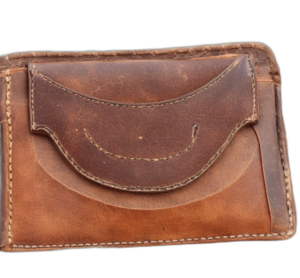

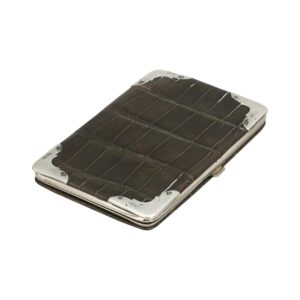
Even before the dawn of the Industrial Revolution, wallets were being produced at a local and regional scale. Back then, the manufacturing processes were rather primitive. However, as industrialization took hold, a multitude of companies worldwide began to produce and popularize wallets for the general public.
The Industrial Revolution and the Wallet Revolution
With the rise of industrialization and the adoption of mass production techniques, wallets became widely available to everyone. Not only did this open up a plethora of styles and designs to cater to diverse tastes and necessities, but it also fostered a change in the materials used in wallet production.
Initially, wallets were fashioned from natural materials such as leather and various types of canvas. However, as advancements in technology came into play, we began to see wallets crafted from innovative materials like shagreen, PU leather, Oxford Canvas Fabric, and various types of Nylon.
The Invention of the Cardholder: A Revolution in Wallet Design
The advent of credit cards, bank cards, and government IDs laid the foundation for a new accessory that many people find indispensable today – card holders.
Diners Club card is considered as the first ever credit card. Frank McNamara and Ralph Schneider were its inventors, and their goal was to create a method of payment without cash.
The emergence of card holders, specifically designed to carry credit cards, debit cards, and other forms of plastic payment, is closely tied to the widespread adoption of credit cards and the shift away from primarily using cash. Credit cards became more prevalent in the mid-20th century, and the need for a compact and organized way to carry these cards led to the development of card holders.
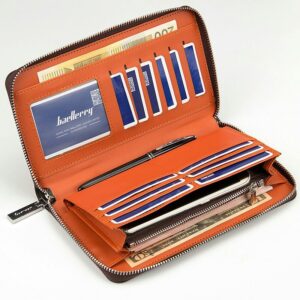
Here are some key points in the timeline of card holders:
- Mid-20th Century: As credit cards gained popularity in the 1950s and 1960s, people began to carry multiple cards for various purposes. Card holders were introduced to provide a dedicated and organized space for these cards.
- 1970s-1980s: The 1970s and 1980s saw a significant increase in the use of credit cards, and the design of wallets and card holders adapted to accommodate this trend. Card holders became more specialized, offering specific slots and compartments for different cards.
- 1990s-2000s: With the continued growth of electronic payment methods and the introduction of additional cards like loyalty cards and ID cards, card holders evolved to include more compartments and features to meet the diverse needs of users.
- 21st Century: The 21st century witnessed a surge in minimalist and slim designs for card holders. The popularity of slim wallets and card holders reflects a preference for streamlined and compact solutions, especially as people carry fewer physical cards due to digital alternatives and mobile payments.
According to the 2021 Experian State of Credit, the average American has 3.84 credit cards.
Today’s Wallets: Balancing Style, Functionality, and Security
In the modern era, wallets are connected to the current challenges, especially digital theft. Our valuable possessions have changed from physical objects to digital pieces of information stored on magnetic plates. As a result, theft has also changed, and so have the ways to prevent it.
This has led to the rise in popularity of RFID-Protected and Signal-blocking wallets and cardholders, which are designed to protect our digital assets.
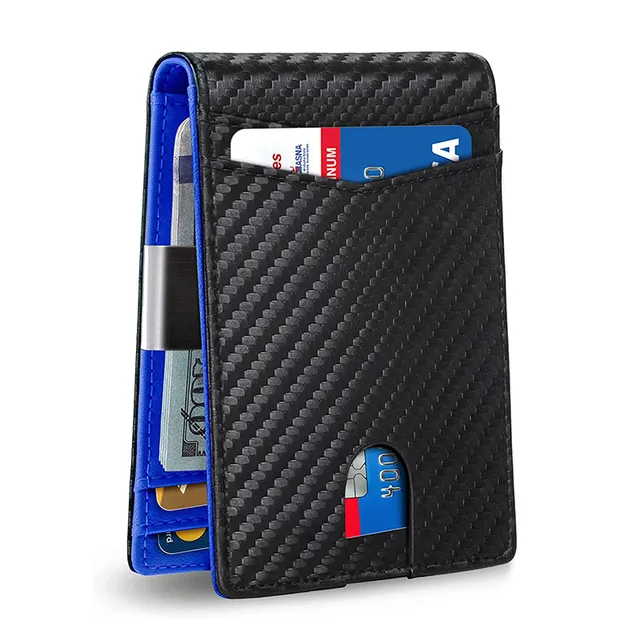
RFID technology is widely used in various credit and debit cards to facilitate contactless payments, enhancing transaction convenience. This technology has already been incorporated into official government identification and passport documents. However, this also presents a potential security vulnerability, as it can be exploited by unauthorized individuals, using RFID scanning devices.
Typically, an RFID wallet incorporates specialized materials that create a barrier against radio-frequency signals, preventing RFID scanners from accessing the information stored on the chips in your cards. Acting as a shield, the wallet blocks the transmission of data, ensuring that your sensitive information remains secure and inaccessible to anyone attempting to remotely skim or steal your card details.
The protective material used in RFID wallets may consist of metal mesh or a specially engineered fabric that stops the radio waves used in RFID communication. By utilizing an RFID wallet, people can add an additional layer of security to their credit and bank cards, effectively safeguarding against potential electronic theft or unauthorized access to personal information.
RFID = Radio Frequency Identification. It's a wireless system comprised of two elements: tags and readers. The reader is a radio waves emitter that has one or more antennas and receive signals back from the RFID tag. RFID tags are tiny electronic gadgets that store data and can interact with other devices through radio waves.
Digging Deeper into RFID Technology
When we talk about RFID systems, there are two primary frequencies that they operate on, and these differ based on the application and the location. Let’s break that down:
First off, we have Low-Frequency (LF) RFID. This operates around the 125 kHz mark and is typically used for things like access control systems, tracking animals, and even in some credit card applications.
Then we have High-Frequency (HF) RFID, which operates closer to 13.56 MHz. This type of RFID is quite commonplace and you’ll find it in contactless smart cards, as well as in various access control cards.
Keep in mind, RFID wallets are primarily designed to block signals in the LF and HF ranges. There’s another frequency, the UHF (Ultra High Frequency) range that operates around 860-960 MHz, but RFID wallets aren’t intended to block these signals. UHF RFID is more commonly found in logistics and inventory tracking, and not in credit cards or identification cards.
In conclusion
In conclusion, throughout history, the necessity to safeguard personal items has been of paramount importance to individuals. The human instinct for exploration and movement necessitated the need for a secure, handy means to carry one’s valuables. Regardless of the terminology used across different eras to denote these carry accessories, their significance persists, and if anything, holds even greater weight nowadays.
In today’s world, we crave not just function but also fashion. We strive to showcase ourselves as modern, confident, and in touch with the latest trends. Moreover, we encounter new risks and difficulties that modern wallet must confront.

